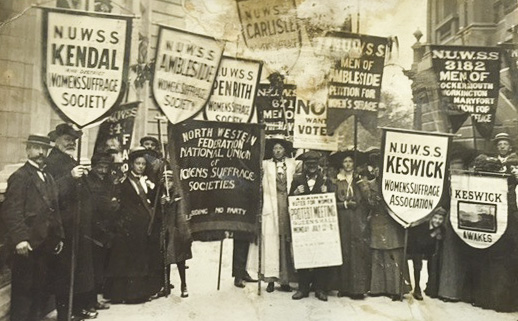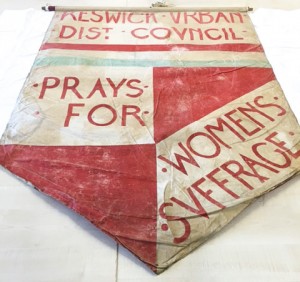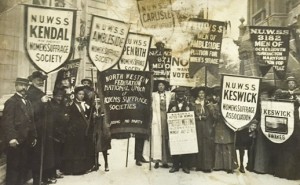
Catherine Marshall became prominent in suffragist and peace activism, significant national movements in the last century. The National Union of Women’s Suffrage Societies (NUWSS) was established at the end of the 19th century with branches in different areas. In 1903 there was a splinter group, the Women’s Social and Political Union (WSPU), whose members believed more militant action was needed. Peaceful means rather than direct action was the approach advocated by the NUWSS. Catherine was a suffragist and member of the NUWSS rather than a suffragette and member of the WSPU. She went from small-scale activism in Cumberland to being a key player in the national movement. When war broke out, she also became heavily involved as a peace activist.
Catherine Marshall (1880-1961): From Suffragist to Peace Activist, Part 1: Suffragist
Posted by Gail Capstick
Catherine Marshall, born 1880, and her brother Hal, born 1883, were of respectable middle class parents, Caroline and Frank Marshall. (1) The wider Marshall family owned property in the Lake District, (2) and Frank had a house built at Hawse End, near Keswick. Frank was a master at Harrow School and Catherine’s early years were spent in London. Her school years were firstly at a private school run by her aunts, where her mother had previously taught. (3) At 16 she went to boarding school in Scotland, (4) and left aged 19. (5)Catherine did not go on to higher education, nor did she work in a paid capacity. Frank retired in 1904 and he, Caroline and Catherine moved to Hawse End, a house he owned near Keswick and where the Marshall family had been regularly for long school holidays while the children were in their teens. (6)
Suffragist activities within Cumberland and the North West

Keswick Urban District Council women’s suffrage banner, held in the Catherine Marshall collection
Image courtesy of Cumbria Archive Centre, Carlisle: Ref DMAR/14/1
Thanks to Keswick Town Council for permission to reproduce this image
Catherine and her mother and father were key players in the Suffragist movement in Keswick from 1908. A branch of the NUWSS, the Keswick Suffrage Society (KWSA) was formed by her mother, Caroline, and others at her home. Caroline was President. Catherine was Honourable Organising Secretary. Catherine’s work whilst at Hawse End involved writing letters, organising meetings, running a stall in Keswick and selling pamphlets, public speaking, arranging a play and organising a caravan. The first Annual Report of the Society for the year 1908 to 1909 lists these activities. (7) The caravan toured areas of Cumberland and was an inspiration to women in Kendal, leading to them setting up a branch of the NUWSS in the adjoining county of Westmorland. (8)
‘… The present time is one of great opportunities and great responsibilities for women.’
Catherine had done formal debating at school and been chair of the debating society. (9) This might have been utilised when she planned some public speaking for the Society: ‘Miss Minnie Broatch and Miss Catherine Marshall volunteered to try their hand at open-air speaking, and found the experience very useful.’ (10) About one such event there was a letter from Mrs Elizabeth Wilson, possibly of Seascale, dated 5th August 1909: ‘My little girls were extremely proud that you spoke to them and they came home quite ardent suffragists.’ (11)
In the summer of 1910 the Keswick branch of the NUWSS held meetings in Keswick, Threlkeld, Cockermouth, Workington, Arlectdon, Frizington, Egremont and Cleator Moor. (12) In June 1910, 17 of the North West suffrage societies formed a federation and their first AGM was held in Carlisle on 20th May 1911. (13) The list of societies in 1912 included Carlisle, Appleby, Ambleside, Hawkshead, Kendal, Keswick, Lancaster, Penrith, Arlecdon, Maryport, St. Bees, Whitehaven, Wigton, Cleator Moor, Silloth, Ulverston, Workington, Barrow, Carnforth and Millom. (14) On 18th April 1914, the NWF divided into two: one for Cumberland and one for Westmorland and North Lancs. (15)
‘… I consider that questions of peace and war are intimately connected with Women’s Suffrage.’
Further afield
Catherine’s activities were not limited to Keswick and, whilst her early activism was only in the Lake District, she began to have more of a national profile. She was willing and able to travel within Cumberland and beyond. In July 1910 she was a member of the delegation from Keswick that attended a demonstration in Trafalgar Square, London. (16)

Catherine Marshall (tallest figure, centre) at suffrage demonstration, London, 1910
Image courtesy of Cumbria Archive Centre, Carlisle: Ref DMAR/10/6
It is unclear when Catherine returned to London to live but her work nationally and internationally began to occupy more of her time and there was less time for activism in Cumberland, as indicated in a letter to a Miss Walker-Jones, dated 6th June 1916. Catherine Marshall writes:
‘For the present I am so seldom in Cumberland and so much absorbed with work in London that I am afraid I shall not be able to do any active local work … All my activities are, however, as I believe, serving the Women’s Movement in one way or another. The present time is one of great opportunities and great responsibilities for women.’ (18)
Catherine was, however, invited back to Keswick by others in her family in 1918 to speak on ‘What the possession of the Parliamentary vote means,’ (19) and she still maintained close links.
Catherine became a key player in the suffragist movement in Keswick and then beyond.
The First World War
If Catherine was not in London when war broke out she would appear to have been there soon after. There was a shift not only in her location but in the focus of her work. In a letter dated 3rd February 1915 to Mrs Oliver Strachey, Catherine writes:
‘I do not consider it within our province to conduct a campaign on any questions totally disconnected from the Suffrage question, but I consider that questions of peace and war are intimately connected with Women’s Suffrage.’ (20)
With the outbreak of war in 1914 there was discussion nationally about whether suffragist activities should be suspended. A decision was made to suspend the campaign and contribute to the war effort. (21) There was not unquestioning support for this within the NUWSS. Millicent Fawcett, NUWSS president, was in support of the war effort, as was the WSPU. Mrs Fawcett wrote in The Common Cause, the NUWSS newspaper, ‘Now is the time to for resolute effort and self-sacrifice on the part of every one of us to help our country.’ (22) Others in the NUWSS, including Catherine who was by then on the Organising Committee, were not in favour and saw an overlap between women’s suffrage and peace activism. Catherine sent a letter of resignation from the NUWSS to Mrs Fawcett on 3rd March 1915. (23)
Catherine sent a letter of resignation from the NUWSS to Mrs Fawcett on 3rdMarch 1915, although she always remained committed to women’s suffrage. (23) She was invited back to Keswick by others in her family to speak on ‘What the possession of the Parliamentary vote means’ in 1918 and still maintained close links with the suffrage movement. (24) She received posthumous recognition of her suffrage work in 2018 and was one of the names of men and women unveiled on the statue of Millicent Fawcett in Parliament Square. (25)
Concluding remarks
Suffragists were one part of a movement to obtain votes for women. Catherine Marshall’s work involved organisation and leadership and showed flexibility of approach. On occasions her work was similar to that of a missionary, going out, speaking and enlisting support. She sought people for particular roles. She made contact with politicians in the three political parties. She was an initiator, an influencer and a networker, working to break power blocks and adopting a systematic and structured approach. She got things done. Although not particularly militant or radical, she was willing to put her head above the parapet and state her case. She was influential in changing consciousness, as indicated in the quotation above about her impact on Mrs Wilson’s two young girls.
Catherine became a key player in the suffragist movement in Keswick and then beyond. From activism on a small stage in 1908, she took on more of a national profile and rose to prominence in the NUWSS as a member of the Organising Committee. Many of the skills she developed and honed were from the early days of her activism in Cumberland.
- Vellacott, Jo, 1993. From Liberal to Labour with Women’s Suffrage: The Story of Catherine Marshall (Montreal: McGill-Queen’s University Press), p.4.
- Bott, George, 1994. Keswick: the Story of a Lake District Town. Cumbria County Library, p.61.
- Vellacott, Jo, 1993, From Liberal to Labour with Women’s Suffrage: The Story of Catherine Marshall (Montreal: McGill-Queen’s University Press), p.5.
- Vellacott, Jo, 1993, From Liberal to Labour with Women’s Suffrage: The Story of Catherine Marshall (Montreal: McGill-Queen’s University Press), p.9.
- Vellacott, Jo, 1993, From Liberal to Labour with Women’s Suffrage: The Story of Catherine Marshall (Montreal: McGill-Queen’s University Press), p.16.
- Vellacott, Jo, 1993, From Liberal to Labour with Women’s Suffrage: The Story of Catherine Marshall (Montreal: McGill-Queen’s University Press), p.6.
- Papers mainly relating to the establishment of the Keswick Women’s Association, 1908-1909. Archive ref: DMAR/3/1, Cumbria Archive Centre, Carlisle.
- Smalley, Roger, 2013. Agitate! Educate! Organise! Political Dissent in Westmorland from 1880-1930. Cumberland and Westmorland Antiquarian and Archaeological Society, p.18.
- Vellacott, Jo, 1993. From Liberal to Labour with Women’s Suffrage: The Story of Catherine Marshall (Montreal: McGill-Queen’s University Press), p.12.
- Papers mainly relating to the establishment of the Keswick Women’s Association, 1908-1909. Archive ref: DMAR/3/1, Cumbria Archive Centre, Carlisle.
- Papers mainly relating to the establishment of the Keswick Women’s Association, 1908-1909. Archive ref: DMAR/3/1, Cumbria Archive Centre, Carlisle.
- Papers mainly relating to the cause of female suffrage in Cumberland, 1910. Archive ref: DMAR/3/2, Cumbria Archive Centre, Carlisle.
- Papers mainly relating to the cause of female suffrage in Cumberland, 1911. Archive ref: DMAR/3/3, Cumbria Archive Centre, Carlisle.
- Papers relating to the cause of female suffrage in Cumberland, Westmorland and North Lancashire, 1912. Archive ref: DMAR 3/4, Cumbria Archive Centre, Carlisle.
- Papers relating to the cause of female suffrage in Cumberland, Westmorland and North Lancashire, 1914. Archive ref: DMAR 3/5, Cumbria Archive Centre, Carlisle.
- Papers mainly relating to the cause of female suffrage in Cumberland, 1910. Archive ref: DMAR/3/2, Cumbria Archive Centre, Carlisle.
- Letter dated 21 September 1915. Archive ref: DMAR/4/7, Carlisle Archive Centre.
- Letter dated 6 June 1916. Archive ref: DMAR 3/5, Cumbria Archive Centre, Carlisle.
- Papers relating to the cause of female suffrage in Cumberland, Westmorland and the North West, 1918. Archive ref: DMAR 3/6, Cumbria Archive Centre, Carlisle.
- Letter dated 3 February 1915. Archive ref: DMAR 3/44, Cumbria Archive Centre, Carlisle.
- NUWSS, 1915. Suffragists and the War: What the National Union is Doing.
- The Common Cause, 18 December 1914, p.11.
- Records relating to work for the NUWSS as a member of the Executive Committee and Parliamentary Secretary, 1915. Archive ref: DMAR/3/45, Cumbria Archive Centre, Carlisle.
- DMAR 3/6, Cumbria Archive Centre, Carlisle.
- Saul, Heather, 24 April 2018. Millicent Fawcett statue unveiling: the women and men whose names will be on the plinth. Inews

